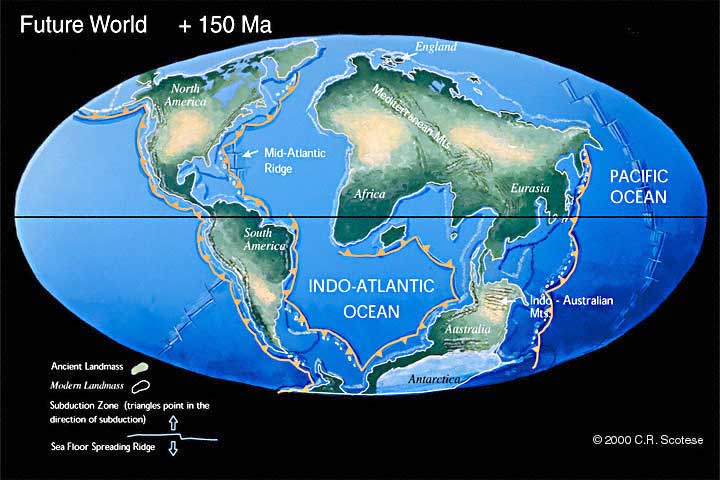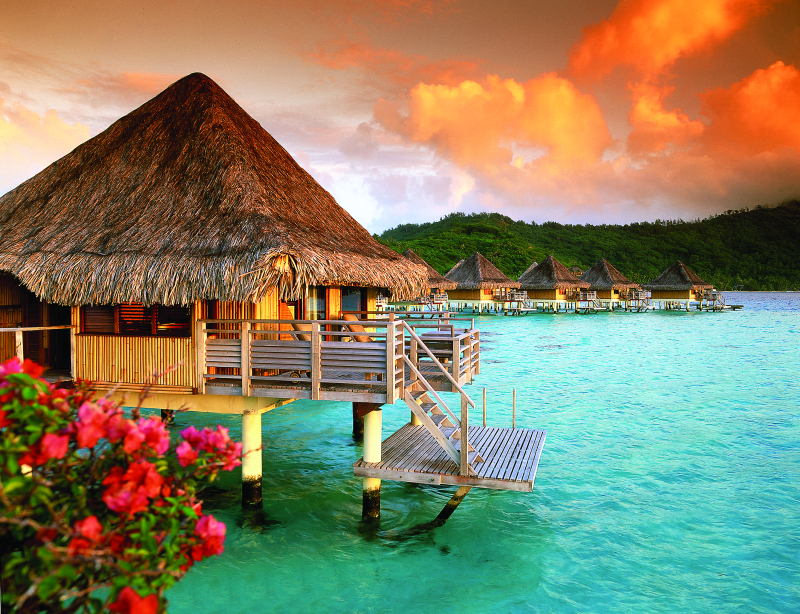Now as I've stated before, yes the island is a place for a beautiful escape from reality but it is far more than that geographically. This island is extremely unique from its vividly transparent waters, to its original landscape and ecosystems, and we can't forget its unmatched climate and weather! All of these factors have shaped Bora Bora into what it is today!
Bora Bora was created due to the eruption of a volcano from the sea floor and as the volcano sank back into the Pacific Ocean, a ring of coral reefs, formed to mark the coastline for the modern island that we have today!
 |
| Beautiful aerial shot of Bora Bora and the two erupted volcanoes of Mount Pahia and Mount Otemanu! |
Trying to predict the future is an interesting thing, its also a terrifying reality check. Right now in the year 2014 the island is a perfect tropical vacation luxury, but in 10,000 years it might be a long lost memory. As stated early in this blog series, Bora Bora is located right along the equator line (water locked in the Pacific Ocean) which is what makes it such a perfect vacation spot, but this could possibly be the reason for its extinction in the future. With the greenhouse gas effect melting the polar ice caps this island in the ocean will eventually be under the sea. According to Richard B. Alley, a climate scientist at Pennsylvania State University who has studied the polar ice
sheets for decades, "while a large rise of the sea may now be inevitable from West
Antarctica, continued release of greenhouse gases will almost certainly
make the situation worse. The heat-trapping gases could destabilize
other parts of Antarctica as well as the Greenland ice sheet,
potentially causing enough sea-level rise that many of the world’s
coastal cities would eventually have to be abandoned."
 |
| This image shows how drastically the Polar Ice cap is melting. |
Bora Bora 1,000,000 Years from Now:
With the information provided early its pretty clear what Bora Bora would look like in a million years.... yup that's right you, you guessed it! Its underwater! By this time, if the greenhouse effect continues, the Polar Ice cap will have melted thus increases the sea level enough to swallow the island. In a million years plate tectonics will provide different types of landmasses from the modern day world. This means that the tiny little island will most likely be destroyed or move along the sea bed with the Australian Plate.
 |
| What the world is predicted to look like 150 million years from today. |
Bora Bora 100,000,000 Years from Now:
Thinking this far into the future, nothing is going to happen for certain or on a set pattern but scientist have made their best predictions and assumptions based on the past and the present of the earth's geographical patterns. By this time the tiny volcanic island in the Pacific Ocean will be long gone. With all of the plate shifts and increase in water in the world Bora Bora will no longer be anything but a part of the sea floor, most likely still a corral reef or a large sand bar. Such a sad end to a beautiful place! I would suggest making a trip there before its gone (you still have plenty of time).
I hop you all have enjoyed the journey of exploring the island of Bora Bora and I hope if you do ever visit this magnificent place make sure to think about all the things we've talked about and discovered!
There won't be a next time due to this is my final blog, but once again and always;
Peace and Love!
Peace and Love!








.JPG)
